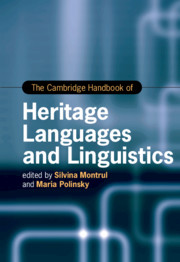Book contents
- The Cambridge Handbook of Heritage Languages and Linguistics
- Cambridge Handbooks In Language And Linguistics
- The Cambridge Handbook of Heritage Languages and Linguistics
- Copyright page
- Dedication
- Contents
- Figures and Tables
- Contributors
- Acknowledgments
- Introduction
- Part I Heritage Languages around the World
- Part II Research Approaches to Heritage Languages
- Part III Grammatical Aspects of Heritage Languages
- Part IV Heritage Language Education
- 29 Elementary School Heritage Language Educational Options and Outcomes
- 30 Community-Organized Heritage Language Programs
- 31 Curricular and Programmatic Language Development Opportunities for University-Level Heritage Language Learners
- 32 Instructed Heritage Language Acquisition
- 33 Issues and Practices in Community-Based Experiential Learning for Heritage Speakers in the United States
- 34 Developing Spanish Heritage Language Biliteracy
- 35 Heritage Language Assessment
- 36 Embracing Opportunity in Heritage Language Revitalization
- 37 Heritage Language Planning and Policy
- Index
- References
37 - Heritage Language Planning and Policy
from Part IV - Heritage Language Education
Published online by Cambridge University Press: 04 November 2021
- The Cambridge Handbook of Heritage Languages and Linguistics
- Cambridge Handbooks In Language And Linguistics
- The Cambridge Handbook of Heritage Languages and Linguistics
- Copyright page
- Dedication
- Contents
- Figures and Tables
- Contributors
- Acknowledgments
- Introduction
- Part I Heritage Languages around the World
- Part II Research Approaches to Heritage Languages
- Part III Grammatical Aspects of Heritage Languages
- Part IV Heritage Language Education
- 29 Elementary School Heritage Language Educational Options and Outcomes
- 30 Community-Organized Heritage Language Programs
- 31 Curricular and Programmatic Language Development Opportunities for University-Level Heritage Language Learners
- 32 Instructed Heritage Language Acquisition
- 33 Issues and Practices in Community-Based Experiential Learning for Heritage Speakers in the United States
- 34 Developing Spanish Heritage Language Biliteracy
- 35 Heritage Language Assessment
- 36 Embracing Opportunity in Heritage Language Revitalization
- 37 Heritage Language Planning and Policy
- Index
- References
Summary
First, this chapter locates heritage language policy and planning (HLPP) within the broader context of traditional language planning and policy (LPP). Much of the focus for HLPP falls under the conventional domain of acquisition planning, which generally relates to educational language planning. Next, the chapter presents a typology of language policy orientations and considers their implications for HLPP. The chapter then revisits the influential work of Ruíz regarding the language-as-resource policy orientation which has been especially prominent in HLPP advocacy. Next, a discussion follows of major historical ideological shifts that have affected policy for heritage language (HL) communities within the US historical context. The chapter then revisits contemporary HLPP advocacy and reviews recommendations for promoting macro K-university policies that could encompass HLPPs. Lastly, the chapter concludes that the ongoing legacies of restrictive ideologies of the past need to be confronted as we strive to foster more inclusive engagement with HL communities of the present to ensure successful policymaking.
Keywords
- Type
- Chapter
- Information
- The Cambridge Handbook of Heritage Languages and Linguistics , pp. 934 - 957Publisher: Cambridge University PressPrint publication year: 2021
References
- 1
- Cited by



